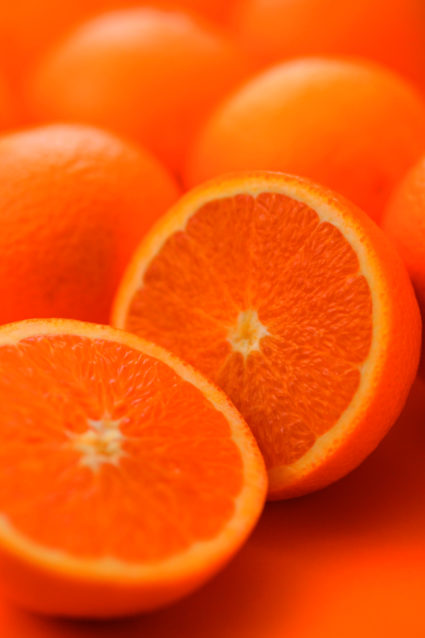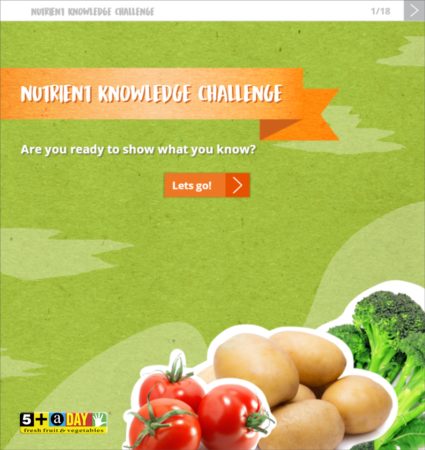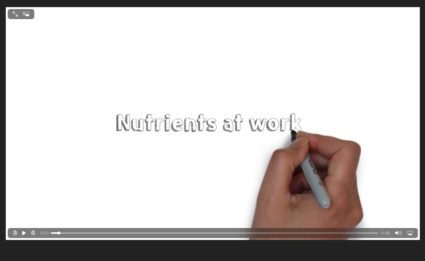Learning Opportunity 2: Why are the nutrients in fruit and vegetables so important for good health?
In this learning opportunity, students will explore the way that different nutrients function in our bodies, with a focus on why fruit and vegetables are so important. Students will undertake an inquiry of their own choice to broaden their knowledge and delve more deeply into the importance of a specific nutrient for maintaining good health.

Learning Intentions

Students will:
- discuss the importance of nutrients in fruit and vegetables
- explore how nutrients contribute to our physical health, which in turn impacts on our social, mental, and emotional well-being (hauora)
- understand that nutrients have many different functions in keeping our bodies healthy
Possible Achievement Objectives
Health and Physical Education: Level 5
PERSONAL GROWTH AND DEVELOPMENT
Students will:
- describe physical, social, emotional, and intellectual processes of growth and relate these to features of adolescent development and effective self-management strategies
Science: Level 5
LIFE PROCESSES
Students will:
- identify the key structural features and functions involved in the life processes of all plants and animals
Preparation
Materials
For this and other lessons, there is a range of resources to use to prepare for the topic, and where appropriate, to share with students.
- Nutrients at work - Animation: Before the lesson, work through the animation, so you are familiar with the interactivity and the content, and decide what technology you’ll use to engage the students (for example, an IWB).
- Nutrient Fact Files
Key Vocabulary
During this learning opportunity, key terms are used. Click on an underlined word to view a definition. You can define and explore these terms in context as you discuss this topic with your students.
The Learning Opportunity
This learning opportunity contains suggestions for helping students begin to understand the nutrients for good health, especially fresh fruit and vegetables. You can adapt the approach and activities, as needed, to support your students as they carry out their inquiries. Your role is to help your students generate rich questions about the topic of how nutrients work to keep your body healthy, rather than simply providing them with information about the topic.
Note: As a part of every learning opportunity, you can reinforce the message that eating 5+ A Day fresh fruit and vegetables is an important part of making healthy lifestyle choices.
If your students did not take part in the Nutrient Knowledge Challenge during Learning Opportunity 1, they could do it now (click on the image to download and play). If laptops or tablets are available, this can be done in pairs or small groups. Or to involve the whole class, this can be done collaboratively using an IWB. It’s important that you familiarise yourself with this activity prior to taking it with the class. It involves interactivity to engage students in their exploration.
Begin the learning opportunity by reviewing what students learned about specific nutrients during the inquiries they undertook in learning opportunity 1. Use sticky notes to record short statements about their learning. Decide on the best way to collect the information so everyone has access, such as in a Google doc or on a chart that can be displayed on the classroom wall.
- What nutrients do you know?
- In what foods is it found? Why is it important? What does it do? (importance of different foods for health – calcium for bones, protein for muscles, carbohydrates for energy)
- What kinds of foods are better for us than others? (Hopefully fruit and vegetables are top of mind for them, as well as fresh and non-processed foods.)
Eat food, not too much, mostly plants
Tell students that this learning opportunity will focus on the question: Why are the nutrients in fruit and vegetables so important for good health? Write on the board the following quote from American writer Michael Pollan: “Eat food, not too much, mostly plants.”
This could be used as the starting point for a discussion around the importance of nutrients found in fruit and vegetables and the fact that they are a vital part of a meal – fruit can be part of a main meal as well as a snack and dessert. You could briefly remind students about eating 5 or more servings of fresh fruit and vegetables every day. Specifically, we should eat two servings of fruit and three or more servings of vegetables.
- What do you think Michael Pollan means by ‘plants’? (the food that comes from plants, which are fresh fruit and vegetables)
- What foods come from plants?
Hold up a range of fruit or vegetables (or photos of them) that provide different nutrients (carbohydrates, vitamins and minerals, dietary fibre). Ask:
- Why do you think this [fruit/vegetable] is good for you?
- What nutrients do you think it contains? How does it help you stay healthy?
You want the general discussion to focus on the fact that fruit and vegetables don’t just provide energy – they are full of nutrients, like vitamins and minerals, which are important for health, high in dietary fibre, have a high water content, and are low in fat and sodium.
Nutrients at work - Animation
Together, watch the Nutrients at work animation (using an IWB) to give students a visual picture of where nutrients go in the body, such as the brain, heart, eyes, bones, tissue/cells, and how they work to enable such things as immunity, hydration, energy, digestion, healthy skin, and well-being. You’ll also be able to confirm or bust some myths about food as you go, too.
On completion, ask the students:
- What did you learn?
- What surprised you?
- What questions do you still have?
Write students’ questions in a ‘parking lot’ on the board.
Nutrient CVs
To expand their knowledge about the nutrients in fruit and vegetables, students could work independently or in pairs to create a CV (curriculum vitae) for a fruit or vegetable. Depending on time, they could start this in class and then share their CVs in learning opportunity 3.
Students could choose from the following fruit and vegetables: blueberry, apple, kiwifruit, avocado, potato, cabbage, broccoli, spinach (leafy green), or lettuce. Ensure that all these fruit and vegetables are covered. Just like a CV, which lists skills and experience, this CV will describe a fruit or vegetable and its qualities and/or features. Information could be grouped under categories such as:
- name, place of birth - where I’m found or grown (on a tree or a plant or in the ground)
- brother or sister (family members)
- features, such as 'I’m tall with leaves'
- strengths (nutritional value and how I help the body function)
- healthiest ways to be prepared and eaten
Students can research their fruit or vegetable and then write a CV. Encourage them to be creative about the way they present the information and the categories they use. Students can then present their fruit or vegetable CV to the class.
Note that students will likely have assumptions about specific nutrients, so they may be surprised to learn about the nutritional content of some fruit and vegetables. For example, most students will know that you get vitamin C from fruit like oranges but may be surprised that kiwifruit and berries and vegetables like capsicums, broccoli, tomatoes, and spinach, also have high levels of vitamin C. They will likely know that calcium, found in dairy products like milk and yoghurt, helps keep your bones strong but may not know that vitamin K (found in celery and cabbage) is also important for the development of healthy bones.
Student inquiries
After watching the animation, ask students to think of questions that will extend their understanding and act as the focus for an inquiry (getting into the specifics about what the key nutrients do to help our bodies function and why they’re so important for good health) that they can take on independently or in pairs.
Students could choose to use a question from the parking lot if it is rich enough to support an inquiry. Whatever they choose to do, they need to use a rich, open question as a catalyst, and aim to present their findings to the class clearly and concisely. The intention is that these activities can be undertaken outside of class time and presented at the beginning of the next learning opportunity.
Diving Deep
They can formulate questions around the areas they want to investigate, for example:
- How does your body use a specific nutrient? (Students can choose a nutrient, such as a mineral like iron or calcium or a vitamin like Vitamin B.)
- What are the health benefits of this nutrient?
- What are the fruit and vegetable sources of this nutrient?
- How do you see those benefits, for example, healthy heart.
- What might happen if your body doesn’t get enough of this particular nutrient?
Note: you could introduce this section by telling students the story of scurvy, a skin disease caused by a deficiency of vitamins C and B. In the 18th century, many sailors at sea for long periods died from scurvy (called the scurge of the sea), but it wasn’t known what caused it. Symptoms included feeling weak and tired, and having swollen arms and legs, skin ulcers, and gum disease. In 1747, a Scottish doctor named Lind discovered that scurvy could be prevented by eating citrus fruit (which are a good source of vitamin C) and fresh fruit and vegetables. Scurvy isn’t common today but people who are deficient in vitamins C and B can still get it.
To undertake their inquiry, students can use the sources on the information hub, as well as doing their own research on the internet. Encourage them to report back to the class in innovative ways, for example, a 3-D model, simple animation, PowerPoint presentation, or flow chart.

Reflection
To finish, allow time to reflect on the learning outcomes and to talk and share ideas that are still unclear.
In reflecting on this learning opportunity, the discussion will focus on:
- why fruit and vegetables are so important for health
- how nutrients are used in the body
To conclude, you could show Mason Durie’s Te Whare Tapa Whā model with its four dimensions (walls) – physical health, spiritual health, family health, and mental health. Ask:
- How does having a healthy body contribute to our hauora (well-being)?
Generate discussion around the fact that if you don’t get all the nutrition your body needs to be healthy, it will affect your taha tinana (physical health), and if this wall is weak, it affects the stability of the other three aspects of overall hauora.
If there is time, explain that the next learning opportunity will focus on how we can ensure we get the nutrients our bodies need to be healthy.

